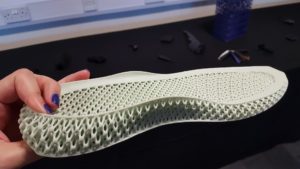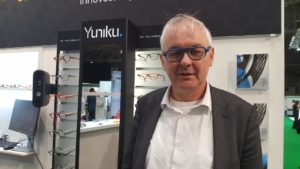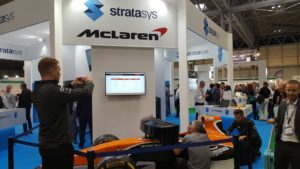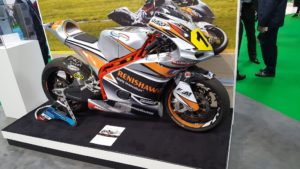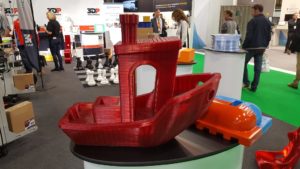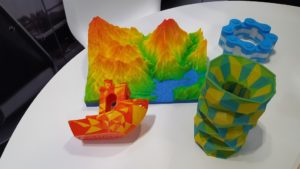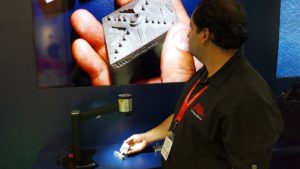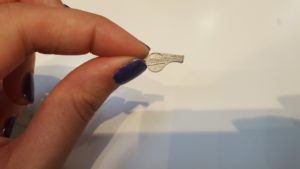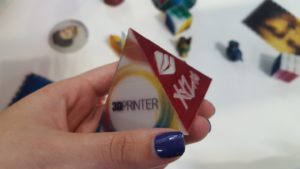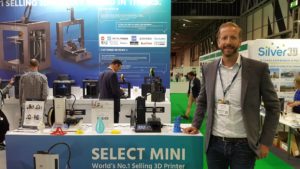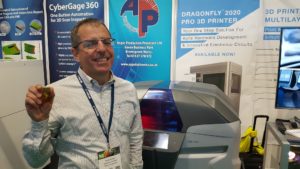This week in the UK, the National Exhibition Centre (NEC) in Birmingham played host for the 22nd TCT Show, an annual affair that brings together the 3D printing industry. With perhaps 10,000 visitors and more than 250 exhibitors, the 2017 edition was certainly one for the books as the three days of the event were filled with interested minds, industry experts, product launches, and an overarching sense of camaraderie in this small but growing space. As 3D printing picks up around the world, events such as TCT Show are critical for building the community around the technology and showcasing some of the latest developments and hints of what’s next to come.
We’ve been tracking many of the announcements arising from the show this week, and I was running (power-walking, to be more civilized) from stand to stand through the duration for a first-hand perspective; by the end of the third day, I was exhausted head to toe, with sore feet and a heavy sensibility of information overload. While there are ways ahead of time to prepare for a 3D printing conference, jumping into the thick of things is a different beast altogether than gathering a list of must-sees, appointments, and other to-dos on a sterile spreadsheet. As always, the insights and new perspectives gained prove the worth of attending in-person, as TCT Show 2017 allowed for a deep personal look into the goings-on of the industry. I appreciated the opportunity this week to revisit and build on existing relationships as well as finally meet face-to-face contacts across the industry with whom I’ve become familiar via email, Skype, and other digital means. From current, guest, and previous contributors to the 3DPrint.com content team to CEOs, executives, representatives, academics, and community members, this week was a delightful reunion and meeting place that reminded me of the brilliance with which the 3D printing industry is awash.
The bulk of each of my days was filled with interview appointments with exhibitors, speakers, and community contributors who each have a unique outlook, while in time not formally scheduled I did my best to walk the exhibit floor to get a feel for the show itself, visit with other familiar faces and intriguing startups, and attend some of the interesting sessions on the conference agenda. The worst part of any given day of a show for me is always a single, seemingly inevitable, question: “What’s the most interesting thing you’ve heard so far?” My response will typically be the same during a show: “I don’t know yet.”
 A day removed from the conclusion of TCT Show 2017, I still don’t think I could pinpoint any one announcement or conversation as “the most interesting”; while that distinction is subjective at best anyway, certainly I didn’t have the chance to talk to everyone I’d have liked to, nor hear every piece of news or see every new product, so I can’t pretend to create a fully-informed opinion on a larger “most interesting” front.
A day removed from the conclusion of TCT Show 2017, I still don’t think I could pinpoint any one announcement or conversation as “the most interesting”; while that distinction is subjective at best anyway, certainly I didn’t have the chance to talk to everyone I’d have liked to, nor hear every piece of news or see every new product, so I can’t pretend to create a fully-informed opinion on a larger “most interesting” front.
That said, I of course had my highlights, and look forward to reporting soon on a delightful crush of interviews, meetings, and presentations.
As with every event a few themes did emerge over the few days, some expected, some refreshing.
Applications:
Footwear and eyewear are taking the spotlight from more established — and still flourishing — applications such as dentistry, with big names including Carbon and Stratasys showcasing their offerings. Materials and processes are expanding as personalized offerings appeal to both consumers and OEMs in unique and custom-fit insoles, shoes, and glasses.
- Carbon’s 3D printed sole for adidas shoes
- Materialise CEO Fried Vancraen wears his custom 3D printed eyeglasses
Aerospace and automotive applications are truly taking off, as tolerances are being met for critical-use applications. Renishaw and 3D Systems were among those showing off electric/race car applications for their technologies, while Cranfield University’s Dr Filomeno Martina graciously previewed his presentation on the Wire + Arc Additive Manufacture (WAAM) process for me privately, including a look at a satellite component that has shown impressive results in testing as well as detailing some of the large hopes for the technique.
- Stratasys brings 3D printing to McLaren
- 3D Systems showcases work with Renault
- Renishaw is working on several automotive projects
Medical applications are gaining ground as more certifications are reached for processes, materials, and implants helping to save and enhance the quality of patient lives. Hip implants, surgical planning guides, prosthetics, and more were visible across the show floor as 3D printing and related software serve medical needs around the world. FabRX won the show’s startup award for their work in 3D printed medications. Johnson & Johnson presented an interesting session highlighting the ways in which the global giant is bringing 3D printing into play throughout their operations to help people.
Not necessarily an application in and of itself, but at the heart of all developments, benchmarking has been in sight as new technologies are developed and require testing, as well as simply for testing desktop 3D printers. I appreciated the opportunity to finally meet intrepid designer Daniel Norée and chat about the creation with CreativeTools of the ubiquitous #3DBenchy benchmarking tool, examples of which were scattered throughout the showroom floor from Desktop Metal’s tiny metal Benchy to 3D Platform‘s massive plastic Benchy, and myriad sizes and materials in between. Away from the popular boat model, the University of Nottingham’s Professor Phill Dickens announced the official launch of the country’s Additive Manufacturing Strategy, where benchmarking on a larger scale is in sight from a regulatory perspective, deriving from a collaborative effort across industry, academia, and government.
- 3D Platform’s large Benchy
- Multi-colored Benchy from ZMorph
Technologies:
Metal. We always have to start by noting that metal additive manufacturing is in sight these days, don’t we? Desktop Metal and Digital Metal both showcased their technologies for their first time at TCT Show 2017, and were in good company with a slew of metal technologies seen from end to end on the show floor.
- Desktop Metal CEO Ric Fulop zooms in on detail
- Digital Metal makes a big impact in small metal 3D printing
Polymers aren’t being left behind by any stretch, as CONTEXT analyst Chris Connery pointed out in his talk on Facts, Figures, and Future; CONTEXT is noting powder bed fusion as a major focus, with work from HP coming into play in the increasing visibility of polymers on the market. While metal technologies account for the lion’s share of revenues (80% by Connery’s accounting), polymers are also in the limelight and expected to see significant growth.
Desktop 3D printers were of course on full display as extrusion-based technologies remain a mainstay. XYZprinting highlighted their new full-color capabilities, alongside their expansive line of popular, low-cost offerings. Monoprice was recently revealed as providing the top-selling desktop 3D printer in the world, by unit sales. A slew of additional desktop units, including the latest 3D printer from Prusa, drew attention across the show floor. Professional-targeted units, including those from Rize and Nano Dimension, provided a look at more complex capabilities in strength and electronics applications, while the latest machine from ZMorph provides what the company’s CEO called a perfect balance between its various capabilities, with 3D printing, CNC milling, and laser engraving in one desktop unit. Showing off the capabilities of its broad line of offerings, EnvisionTEC created a complex dog (#TCTDog) using a variety of means and materials.
- Color FFF 3D printing from XYZprinting
- Shane Igo, VP of Product Management, Monoprice
- Robert Even, Materials Manager, Nano Dimension
- EnvisionTEC’s #TCTDog
Material recycling remains in sight; while additive manufacturing maintains a reputation for being environmentally friendly due to the need to use only as much material as a particular design requires, rather than milling away or otherwise removing material as in traditional subtractive techniques, supports and other excess material often come into play. Digital Metal highlighted the lack of need for supports in builds, saving significantly on the use of expensive metal materials. On the polymeric side, 3devo showcased their material recycler and extruder dedicated to enhancing the value proposition of materials in use.
Business:
So far as product introductions went, this was a busy event in buzz, though it seems some major product announcements are being saved for the upcoming formnext event in Frankfurt, which will be home to a good number of announcements, some of which are already highly anticipated and some as yet in the form of whispers and off-the-record conversations and hints. It is safe to say that formnext 2017 will be an event not to be missed. So far as actual on-site announcements at TCT Show, though, we did hear about plenty of new materials, software launches, a few first tech showings in the UK, some new 3D printers, and collaborations, among others.
Conversations and presentations also revealed several new 3D printing facilities, including Materialise‘s new facility in Poland opened last week and a note about next week’s opening of its expanded facility in Belgium. The company’s CEO noted that this has been a very busy period for the growing company, including the enhanced operations and the addition of two new HP 3D printers, bringing them to eight Multi Jet Fusion machines.
A frequent conversation as well in the overarching community surrounding 3D printing is also frequently debated: should technologies be open- or closed-source? The open source community had a strong showing throughout the week, including a dedicated open source dinner held on the Wednesday night, organized by E3D, where I appreciated the opportunity to be surrounded by some of the strongest minds behind the open source ethos. While I didn’t stay long (the excitable community stayed out far past what my weak human body could take following two days of the show and the previous night’s thumping exhibitors’ evening), the face time at the dinner was invaluable as the community continues to grow.
Held during the same evening as the open source dinner, TCT hosted their first annual TCT Awards; we’ll soon be taking a look at some of the winners chosen by an independent jury of judges. Five significant figures in 3D printing were the first inductees into the Hall of Fame, celebrated for their undeniable contributions to the industry. Certainly these five notables — Adrian Bowyer, Chuck Hull, Hans Langer, Scott Crump, and Fried Vancraen — are all absolutely deserving of the recognition for their invaluable work in establishing and advancing additive manufacturing; at the same time, it will admittedly be refreshing to see future inductions adding a more diverse spread of key figures in 3D printing.
As the industry grows, so too does the diversity of participants; it was wonderful to note during the show that a growing proportion of my interviews were with women and people of color, and that representation of a broader cross-section of individuals were present. Highlighting diversity in business was the excellent #3DTalk panel, in which four women presented a panel discussion on materials, moderated by Women in 3D Printing founder Nora Touré and TCT Deputy Group Editor Laura Griffiths. The conversation highlighted heightened visibility for more industry participants, with representatives from LPW Technology, Added Scientific, Carbon, and Somos sharing their experiences, challenges, and a look at what’s to come in materials and industry.

#3DTalk Birmingham panelists (L-R): Martine van der Ent, DSM Somos; Dr. Nicola Jones, LPW Technology; Sophie Jones, Added Scientific; Dana McCallum, Carbon
A further spread in industry diversity was one more casually noticed, but a definite rising trend: youth. TCT Show 2017 may have had the youngest overall skew of attendees that I’ve seen at a major 3D printing conference, and was to the best of my knowledge the first time that in a conversation with seven other people I realized I was the oldest person in the circle by a fair margin of years. I’m only…we’ll say thirty-something…and still accustomed to being among the younger side of heavy business conversations. While I felt a brief impulse to pick up some wrinkle cream, outside the surprise was a sense of contentment: that engineers and even fellow journalists are a decade younger than me shows that there’s a definite rise in education surrounding additive manufacturing. Rising awareness of the technology at the educational level is critical for the technology to have any real hope of growing as a profession and as an industry unto itself. In discussing how-did-you-get-into-this-field, a common origin story conversation at such events, one company representative said he’d heard of 3D printing in a dedicated college course; turned out that course was held in 2017 and he’s a recent graduate now gainfully employed in AM. While most of us have wandered into this industry from a variety of backgrounds, for the first time we’re truly seeing a rise of participants coming into the workforce to start off with a career in 3D printing, particularly as courses and even dedicated degree tracks emerge at the university level (not to mention the importance of starting students younger).
Overall:
This quick (“quick”) overview is the tip of the 3D printed iceberg; as with every major conference, TCT Show this year has provided more information, even from a large step back, than could be summed up in a single recap.
TCT Show 2017 provided, outside a wealth of announcements and introductions, the ever-welcome opportunity unique to large gatherings to observe and engage in the professional and interpersonal dynamics and relationships that make up the industry. We’ll be continuing to keep an eye to the news emerging from this show, along with a forthcoming healthy dose of exclusive interviews and observations.
[All photos: Sarah Goehrke]
Subscribe to Our Email Newsletter
Stay up-to-date on all the latest news from the 3D printing industry and receive information and offers from third party vendors.
You May Also Like
Meet Xell, xolo’s Budget-Friendly Bioprinter for Labs
Building on its expertise in volumetric bioprinting, xolo has unveiled Xell. This compact bioprinter brings rapid fabrication of complex structures without visible layers to research labs at an unprecedented price....
Axolotl Biosciences Brings Biotech to the Forefront at Formnext 2024
Formnext 2024 is known as the world’s leading trade fair for industrial 3D printing, with towering machines and manufacturing giants filling its halls. Amid this industrial frenzy, Axolotl Biosciences, a...
BICO’s €26M Nanoscribe Sale Highlights Strategic Overhaul Under Forss
BICO (STO: BICO) announced its second divestiture since Maria Forss took over as President and CEO in November 2023. Following the sale of Ginolis last year, BICO has now entered...
3D Systems Pushes New Tech and Partnerships at Formnext
As one of the pioneering companies in additive manufacturing (AM), 3D Systems remains a key player to watch at Formnext 2024, where it is showcasing major partnerships, innovative technologies, and...



